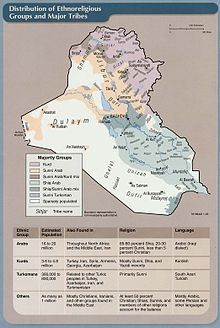Sunni Islam in Iraq

Sunni Islam in Iraq (Arabic: الإسلام السني في العراق) is the second-largest sect of Islam in Iraq after Shia Islam. The majority of Iraqi Sunni Muslims are Arabs. Iraqi Sunni Muslims mainly inhabit the northern half of Iraq. Sunni Arabs primarily inhabit the Sunni Triangle, Upper Mesopotamia and the desert areas, such as Al-Anbar Governorate in the Arabian Desert and Syrian Desert. The Sunni Kurds inhabit the mountainous Iraqi Kurdistan region.
Sunnis make up around 40% of Iraqis.[1] A CIA World Factbook report from 2015 estimates that 29–34% of the population of Iraq is Sunni Muslim.[2] According to a 2011 survey by Pew Research, 42% of Iraqi Muslims are Sunni.[3] There were about 9 million Sunni Arabs and 4 million Sunni Kurds in Iraq as of 2015.[4]
History[edit]
In the early Islamic period, Iraq was a key center of the Abbasid Caliphate, with the city of Baghdad serving as its capital from the 8th to the 13th century. Sunni Arabs played a significant role in the administration (including the ruling Abbasid dynasty) and cultural life of the caliphate, and many important figures of Islamic scholarship and literature emerged from Iraq during this time and during the Islamic Golden Age.
During his reign, King Faisal I was keenly aware that his power-base was with the Sunni Arabs of Iraq, who comprised a minority.[5] Iraqi Sunni Arabs were also the backbone of Saddam Hussein's Ba'athist Iraq regime.[6]
Nouri al-Maliki's Shia-led government repressed Sunnis, stressing the Sunni Arab tribes' favourable disposition towards the Islamic State, although they did not share the Salafist beliefs. A number of Sunnis have now taken up arms against the Islamic State to stop its attempts at establishing hegemony.[4] In a survey in 2015, only 13 percent of Iraqi Sunni Arabs believed that their central government in Baghdad was heading in the right direction.[7]
Due to continued repression by the Shia-led government, Sunni Islamist and Ba'athist armed groups such as the Naqshabandi Army took up arms against the government during the 2012–2013 Iraqi protests. This led to the 2013 Anbar campaign and beginning of the War in Iraq against the Islamic State which lasted until December 2017.
Demographics[edit]
Sunni Arabs[edit]
Sunni Arabs primarily live in the Sunni Triangle, a densely populated region of Iraq to the north and west of Baghdad. It extends from Baghdad (the southeast point), Ramadi (the southwest point) to Tikrit (the north point). It also includes the cities of Samarra, Fallujah, Balad and Hīt.[8] They also inhabit Upper Mesopotamia and the areas of the Arabian Desert and Syrian Desert.
Like other Iraqi Arabs, Iraqi Sunni Arabs are descendants of conquerers who invaded Iraq from the Arabian Peninsula in the seventh century. Although a minority, Sunni Arabs dominated Iraqi politics until the United States-led invasion of Iraq in 2003.[9] There are many Sunni Arab tribes in Iraq, including Dulaim, Al-Bu Nasir, Al-Bu Nimr, Al-Ubaid, Otaibah, Shammar and Mutayr.[10]
Kurds[edit]
98% of Iraqi Kurds are Sunni Muslims, while the remaining 2% are Shia Muslims.[11] As a result of the spread of Islam, Sunni Islam became the dominant religion of the Kurdish people, following the Shafi'i school. Islam is thought to be a religion of governance as well as spirituality, Kurds make sure to keep both their spiritual identity and national identity strong.[12] Their practices and beliefs are very similar to those of Sunni Arabs.[10]
Turkmens[edit]
Most of the Turkmen live in the Turkmen strip in the area separating the Arabs and Kurds in the cities of Jalawla , Al-Saadiyah, Kifri, Sulaiman Bek, Tooz, Yankjah , Kirkuk , Daquq , Erbil, Tal Afar, And Baghdad in the governorates of Kirkuk , Diyala,Erbil,Saladin,Baghdad and Nineveh,where the Turkmen constitute the third biggest ethnicity in Iraq,The Sunni Turkmen constitute about 77% of the Turkmen of Iraq and are spread in Kirkuk and the cities of the Turkmen strip in Jalawla, Al-Saadiyah , Kifri, Suleiman Bek, Yankjah , Erbil ,Tal Afar, And Baghdad, while the Shiite Turkmen constitute about 23% of the Turkmen of Iraq, and they present in the districts of Taza Khurmatu, Daquq, Tooz, Amerli , Qazaniyah, in addition to towns and villages such as Bashir.[13][14]
References[edit]
- ^ "Religious Politics in Iraq". United States Institute of Peace. Retrieved 2024-01-30.
- ^ "CIA World Fact Book". 2021-04-21. Retrieved 2021-04-25.
- ^ Michael Lipka (2014-06-18). "The Sunni-Shia divide: Where they live, what they believe and how they view each other". Pew Research Center. Retrieved 2021-04-15.
- ^ a b "Minorities in Iraq: Pushed to the brink of existence" (PDF). February 2015.
- ^ Masalha, N "Faisal's Pan-Arabism, 1921–33" pages 679–693 from Middle Eastern Studies, Volume 27, Issue # 4, October 1991 page 679.
- ^ Gaub, Florence (2017). "Meet Iraq's Sunni Arabs: A strategic profile". European Union Institute for Security Studies (EUISS).
{{cite journal}}: Cite journal requires|journal=(help) - ^ Mansour, Renad (March 2016). "The Sunni Predicament in Iraq" (PDF). Carnegie: Middle East Center. p. 3.
- ^ Ahmed Hashim (2005). Insurgency and Counter-insurgency in Iraq. Cornell University Press. p. 129. ISBN 0-8014-4452-7.
- ^ "Population of Iraq - Fanack.com". The MENA Chronicle | Fanack. Retrieved 2023-05-05.
- ^ a b "IRAQ: The Role of Tribes". Council on Foreign Relations. Retrieved 2023-05-07.
- ^ Mohamed, Besheer. "Who are the Iraqi Kurds?". Pew Research Center. Retrieved 2023-05-05.
- ^ Aziz, Mahir (2011). The Kurds of Iraq. London: I.B. Tauris. ISBN 978-1-84885-546-5.
- ^ "Irak Türkmenleri". insamer.com (in Turkish). Retrieved 2024-03-30.
- ^ "Irak Türkmenleri̇ | Türkbirkon | Türkiye". Sitemiz. Retrieved 2024-03-30.
